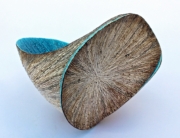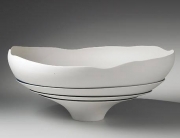Ameyu glazing techniques produce a really interesting sheen, but it takes quite a while for a yakimono ceramics artist to master the style. Its not something that one can learn in a single day. Considering the deep colors that come from ameyu processes the long training process can certainly be worth it.
As with anything, artists who put in many hours of hard work with learning the ameyu trade were rewarded. Individuals who want to make an ameyu glaze needed to add some mineral compound to feldspar in order to create the right look and feel. Most artists used either iron oxide or manganese oxide for this purpose.

Through the Cracks one can see Masterful Artwork in this High Temperature Glaze Yakimono Bowl
The end result creates what many people have referred to as a candy glaze. Ameyu yakimono ceramics have a light caramel color. These pieces usually look quite glossy, which has certainly increased their popularity.
A few ameyu artists preferred to work with other media. Adding cobalt oxide to the glaze provides a deep blue finish. The term cobalt blue is well known in many fields.

Yakimono Piece Exhibiting Traits Usually Associated with Ameyu Feldspar Glazing Techniques
Interestingly enough ameyu artists had to be careful. While these materials produced some of the most brilliant examples of traditional Japanese art, they could also be dangerous. Cobalt oxide is dangerous if its ingested, so potters needed to take certain precautions when making pottery.
Some of the folk ameyu designs have become more popular in recent years. Glaze can be trailed on by using a ladle to create different patterns. This is an imperfect process, but those with an eye for candy glazes don’t mind. In fact, the beauty is often in the imperfections. Collectors prefer to see a bit of a natural touch in pieces they buy.
For instance, an artist decided to decorate one particular ameyu bowl with a white cross design in the middle of it. They took a ladle and poured a pair of thin perpendicular lines across the center of the bowl when they were making it. The lines aren’t at all straight, but nothing in nature is either. That makes the piece that much more valuable.
Many Japanese ceramics aren’t perfect for that reason. Japanese philosophers often stressed the idea of organic shapes. Nevertheless, ameyu work is exacting. These pieces had to endure particularly harsh temperatures to shine they way they do. Many artists lovingly stoked their kilns for hours in order to produce the right type of ceramic glazing. While electric kilns are usually used today, these had to be stoked with firewood. Ameyu glazing techniques were rather demanding at times.




